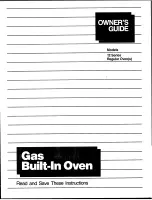
20 English
C
ooking g
uide
Arrangement
Arrange unevenly shaped foods, such as chicken pieces or chops, with the thicker,
meatier parts toward the outside of the turntable where they can receive more
microwave energy. To prevent overcooking, place thin or delicate parts towards
the center of the turntable.
Shielding
Shield food with narrow strips of aluminum foil to prevent overcooking. Areas that
need shielding include poultry wing-tips, the ends of poultry legs, and corners of
square baking dishes. Use only small amounts of aluminum foil. Larger amounts
can damage your oven.
Turning
Turn foods over midway through the cooking cycle to expose all parts to the
microwave energy. This is especially important with large items such as roasts.
Standing
Foods cooked in the microwave build up internal heat and continue to cook for
a few minutes after the oven stops. Let foods stand to complete the cooking
process, especially foods such as roasts and whole vegetables. Roasts need this
time to complete cooking in the center without overcooking the outer areas. All
liquids, such as soup or hot chocolate should be shaken or stirred when cooking is
complete. Let liquids stand a moment before serving. When heating baby food, stir
well and test the temperature before serving.
Adding moisture
Microwave energy is attracted to water molecules. Food that is uneven in moisture
content should be covered or allowed to stand so that the heat disperses evenly.
Add a small amount of water to dry food to help it cook.
Venting
After covering a dish with plastic wrap, vent the plastic wrap by turning back one
corner to let excess steam escape.
Cooking guide
Microwave energy actually penetrates food, attracted and absorbed by the water,
fat and sugar in the food. The microwaves cause the molecules in the food to move
rapidly. The rapid movement of these molecules creates friction and the resulting
heat cooks the food.
General microwave tips
Dense foods, such as potatoes, take longer to heat than lighter foods. Foods with a
delicate texture should be heated at a low power level to avoid becoming tough.
Foods with a non-porous skin such as potatoes or hot dogs, should be pierced to
prevent bursting.
Putting heating oil or fat in the microwave is not recommended. Fat and oil can
suddenly boil over and cause severe burns.
Some ingredients heat faster than others. For example, the jelly in the jelly
doughnut will be hotter than the dough. Keep this in mind to avoid burns.
The altitude and the type of cookware you are using can affect the cooking time.
When trying a new recipe, use the minimum cooking time and check the food
occasionally to prevent overcooking.
Home canning in the microwave oven is not recommended because not all harmful
bacteria may be destroyed by the microwave heating process.
Although microwaves do not heat the cookware, the heat from the food is often
transferred to the cookware. Always use pot holders when removing food from the
microwave and instruct children to do the same.
Making candy in the microwave is not recommended as candy can be heated to
very high temperatures. Keep this in mind to avoid injury.
Cooking techniques
NOTE
If the oven is set to cook for more than 25 minutes, it will automatically adjust to
70 percent power after 25 minutes to avoid overcooking.
Stirring
Open the microwave door and stir foods such as casseroles and vegetables
occasionally while cooking to distribute heat evenly. Food at the outside of the
dish absorbs more energy and heats more quickly, so stir from the outside towards
the center. The oven will turn off when you open the door to stir your food.
ME16K3000A_AA_EN.indd 20
1/21/2016 2:54:28 PM
Содержание ME16K3000A series
Страница 1: ...Microwave Oven User manual ME16K3000A ME16K3000A_AA_EN indd 1 1 21 2016 2 54 23 PM ...
Страница 31: ...English 31 Memo ME16K3000A_AA_EN indd 31 1 21 2016 2 54 29 PM ...
Страница 33: ...Horno de microondas Manual del usuario ME16K3000A ME16K3000A_AA_MES indd 1 1 21 2016 2 51 12 PM ...
Страница 63: ...Español 31 Nota ME16K3000A_AA_MES indd 31 1 21 2016 2 51 17 PM ...
















































